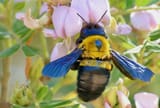Search Results
6/19/2025, 6:13:06 AM
>>713057080
Watched an interesting documentary on carpenter bees, which explains the evolutionary journey of insects into hive social structures.
Essentially, carpenter bees lay eggs in a hole, separating each section with mud and providing nectar for the larvae. They lay one egg per section, but they can select the gender of their eggs. What carpenter bees often do is make the last egg (closest to the entrance) a female and provide half as much nectar as the other sections, resulting in stunted growth for that last larvae. Because the last larvae has the least nectar, it becomes a pupae first and grows into a smaller bee, which the mother can then bully to help feed the rest of the juveniles. This stunted female bee does not reproduce and often dies just feeding its siblings.
This is the hypothetical link toward hive behaviour with queens and workers. Workers don't reproduce, like the stunted bee. Over quadrillions of iterations, some bee species evolved into hives.
Evolution is inefficient, but incredible in the number of permutations it can produce.
Watched an interesting documentary on carpenter bees, which explains the evolutionary journey of insects into hive social structures.
Essentially, carpenter bees lay eggs in a hole, separating each section with mud and providing nectar for the larvae. They lay one egg per section, but they can select the gender of their eggs. What carpenter bees often do is make the last egg (closest to the entrance) a female and provide half as much nectar as the other sections, resulting in stunted growth for that last larvae. Because the last larvae has the least nectar, it becomes a pupae first and grows into a smaller bee, which the mother can then bully to help feed the rest of the juveniles. This stunted female bee does not reproduce and often dies just feeding its siblings.
This is the hypothetical link toward hive behaviour with queens and workers. Workers don't reproduce, like the stunted bee. Over quadrillions of iterations, some bee species evolved into hives.
Evolution is inefficient, but incredible in the number of permutations it can produce.
Page 1
